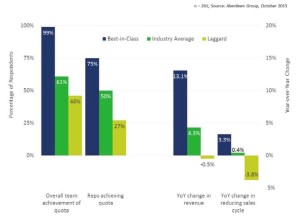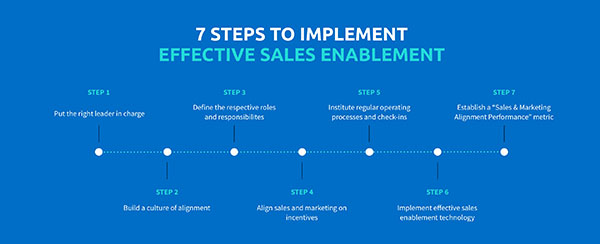As 2015 winds down and you start thinking about your business improvement initiatives for 2016, I’m betting improving sales effectiveness and productivity is on the list.
One of the best ways to do this is to focus on sales enablement.
According to a recent report by Aberdeen Research,  organizations with a formal sales enablement competency see a 99% sales quota attainment and 13% revenue growth rate, 3 times more than companies that don’t. These are performance numbers you shouldn’t ignore.
organizations with a formal sales enablement competency see a 99% sales quota attainment and 13% revenue growth rate, 3 times more than companies that don’t. These are performance numbers you shouldn’t ignore.
From our own State of Sales Enablement research, companies report benefits of sales enablement that include “improving conversion rates, increasing sales productivity, improving ability to sell and delivering quality content.”
You may think that deploying new sales enablement technology or driving process improvements is a massive and overwhelming project, but it doesn’t have to be.
Great gains can be achieved through incremental improvements. And like so many projects, getting started is much easier once you have a plan and can focus on key success factors.
With that in mind, we’ve put together a handful of resources to help you learn about sales enablement platforms and critical steps to follow in 2016 planning.
Planning Steps to START a Sales Enablement Function
- Identify your sales improvement goals. “Sell more” is not specific enough. Is your company’s goal to increase rep effectiveness (convert more) or rep efficiency (better use of time)? Increase conversion rates or sales cycle velocity? And by how much? Each goal needs a specific target number.
- Create a plan to get there. What concrete actions and steps are critical to achieving that goal? Focus on the really critical ones, but identifying all critical steps is essential.
- Who owns managing and driving these goals? Many organizations have realized that sales management cannot focus on selling and driving process improvements at the same time — they’re busy enough selling. That is why best-in-class organizations have created a separate team dedicated to sales enablement with a mandate to drive real process improvements. Regardless of title, it is crucial to have someone, or some team, in charge of driving change, and they need the support of sales and marketing management.
- What resources are required? How much will it cost? How long will various steps take? What resources within the company will be required to be successful? And what cross-functional dependencies are there? You may not have all the answers to these questions, but creating the framework and making early estimates often helps.
- Do you have the right technology in place to support it? The sales tech stack is exploding with powerful tools and platforms to increase sales productivity. Make sure you’re leveraging modern technology to help you, not relying on outdated tech that too often hinders.
Resources to Get You Started
This blog post on 7 Steps to Get Started with Sales Enablement  offers a step-by-step guide to implementing a sales enablement platform, from selecting a project leader through obtaining organizational buy-in through deployment and ongoing accountability.
offers a step-by-step guide to implementing a sales enablement platform, from selecting a project leader through obtaining organizational buy-in through deployment and ongoing accountability.
The Definitive Guide to Sales Enablement contains best practices on content audits, designing a sales enablement solution, deploying technology and evaluating software vendors.
Planning Steps to OPTIMIZE a Sales Enablement Function
If you already have a sales enablement team and a working process but are looking for improvement ideas, here are some steps to improve your performance and increase your impact within the organization:
- Survey your sales team – It may sound obvious, but a quick survey of the field organization to identify their biggest pain points and needs is a great way to find areas of improvement and garner their support at the same time.
- Improve content quality – One of the biggest problems we hear about (aside from finding the content) is content quality. Once you have a good sales enablement process in place, and the sales team is finding the content marketing produces, the next step is to focus on increasing content effectiveness. Leverage content usage, customer engagement, and revenue influence metrics from your sales enablement platform to analyze which content is most effective and why. Focus on improving poorly performing content.
- Analyze best practices – Every sales organization has eagles, average sellers, and laggards. Analyze the practices of your eagles to help train everyone else to be more effective. Look at what they are pitching, how they are engaging the customer, frequency, and so on. Talk with them about their approach. Leverage your sales enablement performance analytics to identify key difference.
- Identify “wasted time” – SiriusDecisions identifies “wasted time” as anything that is not helping the deal move forward nor helping with global sales management. Less time spent on non-selling activities, means more time selling. Leverage surveys to get reps’ opinions and do “ride alongs” to witness the process they must go through to do some daily activities. Some common areas of wasted time include:
- Time spent looking for content: According to a number of studies, reps can spend as much as 4 to 8 hours per week looking for content. This can be cut down drastically with modern sales enablement platforms.
- Expense management: Doing expenses is a common complaint. Tools like Concur take a lot of the time out of logging travel expenses.
- Sales intelligence: Good sales reps do a lot of research on prospects to really understand their business, the players, and their needs before each sale or conversation. There are many sales intelligence tools, such as InsideView, that make this easier for reps.
- Online presentations: Most organizations now leverage online presentation technology to save on travel costs and still engage with customers in an effective way. Make sure you have this technology for your sales team, that it integrates with your sales enablement platform, and that it provides the customer engagement tracking and alerts that make your reps more effective.
- Reassess your sales process to align with the buyer’s process – According to Forrester’s “Death of a B2B Salesman” blog post, the buying process is changing radically and vendors need to adjust their sales processes to survive. Every year, you should reevaluate the sales process to see if it is still optimally aligned to the buyer’s cycle, and what adjustments you could make to be more effective.
These are just a few ideas to improve sales effectiveness. There are many others. Closed-loop technologies that enable performance analysis across customer engagement channels provide the capability to constantly monitor effectiveness and to identify areas of improvement.
Evaluate Your Options
The right sales enablement platform can provide a predictable, measurable, closed-loop sales cycle. It should enable marketers to finally say with certainty how and when content is used and quantify its impact on the performance of every deal. Sales can have more engaging conversations with customers and receive valuable feedback on how and when the customer is viewing their content. That’s some pretty powerful information, but not all solutions are created equal. Selecting the right solution is critical to long-term success. This sales enablement evaluation checklist will help you objectively consider your options.




